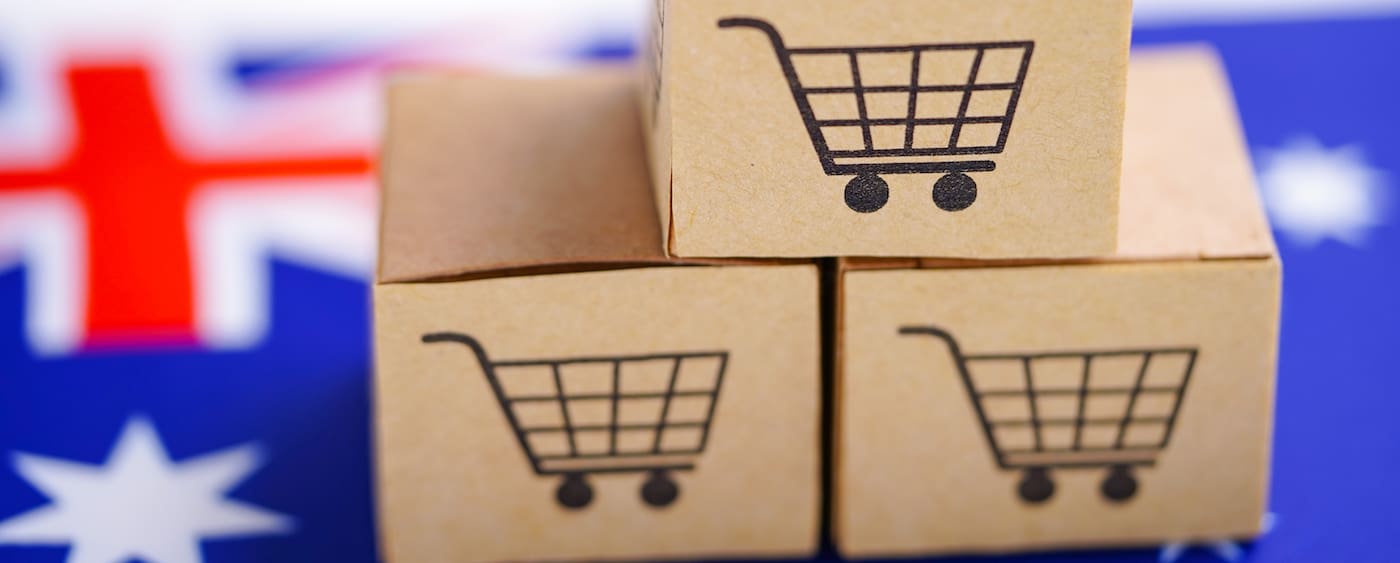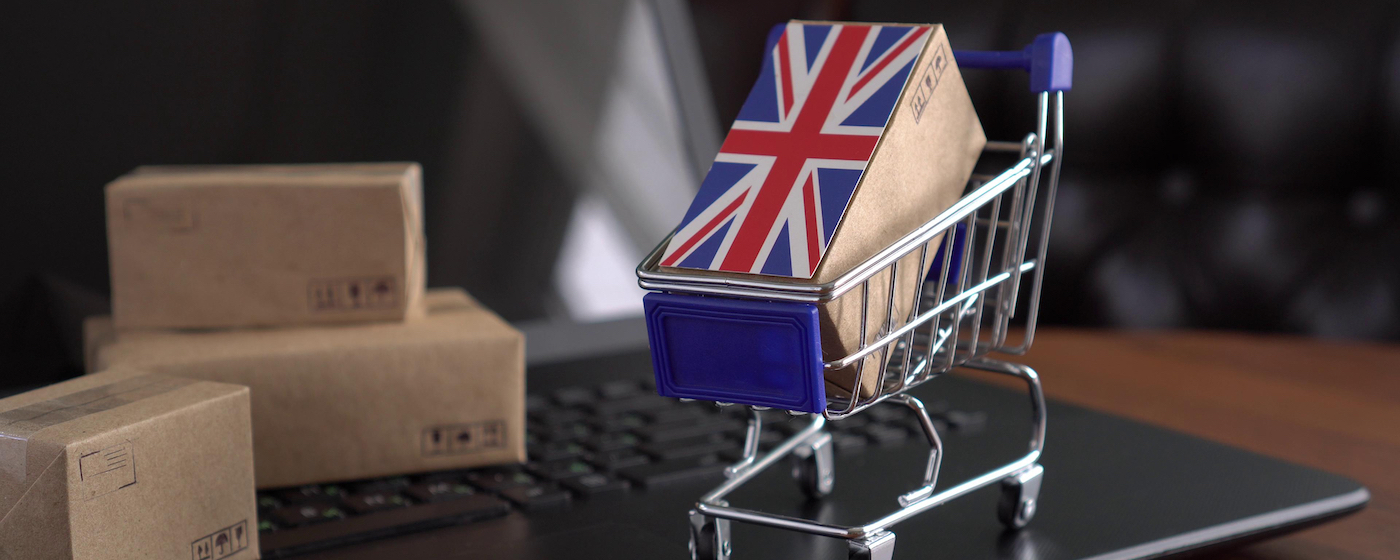Table of Contents
** Minutes
7 steps to selling online in Australia in 2023
Benefits of using marketplaces to sell online
Most popular online marketplaces in Australia
Fulfilment and shipping challenges in Australia
As one of the largest ecommerce markets in the world, Australia is seeing significant online shopping activity.
Australian households are buying online more often, with a 73% year-over-year growth between 2019 and 2022. No wonder there was an increased spending on online purchases in 2021, when Australians spent a record $62.3 billion.
If you’re ready to sell more across Australia, this article provides a step-by-step guide on to sell to the Australian market online.
7 steps to selling online in Australia in 2023
There is lot to consider when you’re first getting started. To help make the process easier, let’s break it down into a step-by-step process.
Step 1: Decide what product(s) to sell
One of the most critical yet challenging steps is deciding what you’re going to sell. This will be the key factor determining the success of your online store.
To determine is a product is going to sell, you’ll want to research the market and identify if it’s in high demand and offers something different than similar products.
While conducting research, there are three things to consider:
- The demand for the product
- The level of competition in the market
- The profit margin
Essentially, a new product should meet a need in the market that is not too saturated — all while having potential to make a reasonable profit margin.
The most challenging part is striking this ideal balance, so most businesses choose between the following two product types:
- Commoditized products: These are products that are differentiated by their competitive pricing. Although they have a lower profit margin, you can still make good money from them since people tend to buy them more frequently, which means you get to sell more of them.
- Niche products: These are products that offer unique features or attributes, typically having higher price points. Although people buy these types of products less frequently, you can make a good profit from them since they boast a higher profit margin.
When you’re just getting started, it’s best to go with products that are easy to package and ship to minimise the risk of damage in transit.
Step 2: Decide where to sell your product(s)
The next step is to decide on the right online channel to sell your products.
Will you sell through your own website? Or will you tap into the existing audience base of popular online marketplaces?
These days, most successful online brands develop a multi-channel retail experience to reach more customers. This might include selling through your website, marketplaces, physical retail, and social media.
If you’re going to leverage an online marketplace, however, make sure to carefully consider your options. For instance, Amazon may be the biggest online marketplace right now, but it can also be extremely competitive.
However, choosing a more niche marketplace means you might have a hard time growing your reach. That said, if you’re selling more niche products, this type of marketplace may be able to help get your products in front of the right customers.
Considering these factors, it’s important to weigh your options and assess the pros and cons of different selling channels before deciding on the most ideal option for you.
Step 3: Figure out where to source your product(s)
Next, it’s time to get strategic with product sourcing.
Are you going to buy from local manufacturers? Or do you plan on working with local suppliers?
Where and how you source your products plays a vital role in your supply chain efficiency. It will also determine how effectively your business can respond to demand volatility further down the line.
You’d ideally want to shop around for suppliers and manufacturers who can meet your demands and maintain the quality standards you want to associate with your business.
Step 4: Obtain legal licenses required
Online businesses in Australia are legally obligated to register their business and get the necessary licenses and permits.
The types of licenses and permits you need will vary depending on factors such as business type, business structure, business activities, and location.
At the most basic level, you’ll need:
- An Australian Business Number Registration
- A Goods and Services Tax Registration
- A National Business Name Registration
Besides these, there are several other licenses and permits that may be specific to the type of business you run and the types of products you sell.
Check out the Australian Business License and Information Service website to find out what you’ll need for your business.
Step 5: Set up a website
Whether you decide to sell via marketplaces or B2B, or both, setting up an online store is essential.
Your online store should be user-friendly but also represent your brand at its core, including your logo, brand colours, and messaging.
When setting up your website, customer safety is important. Make sure customers can checkout securely without the risk of their information being compromised. As such, you’ll need to have your SSL certificate in place and work with a reliable payment platform.
Another major challenge of setting up your own website is figuring out how to attract traffic to your website so you can start making sales.
Other digital marketing efforts can help, including SEO (search engine optimisation). If you’re not aware of SEO best practices, consider hiring someone who can help.
Step 6: Find a fulfilment partner
When selling items online, ecommerce fulfilment is one of the most vital aspects of your logistics operations. It’s the part of your operations that will determine the seamlessness of your ecommerce supply chain and the speed at which customers receive their orders.
At the same time, fulfilment is extremely complex and challenging, especially if you’re new to it. If you’re just starting out, managing fulfilment in house with the right technology is a good starting point.
If you decide to operate your own warehouse and fulfil orders in-house, you can take advantage of ShipBob’s WMS. That way, you can easily manage inventory and track fulfilment automatically and in real time.
“Once we could see the pitfalls in our old manual system of fulfiling orders, we just realised we need something else to scale with. To get where we were going, we would need more structure to support all of our growth — so we switched to ShipBob.”
Bethany Peterson, COO of FlutterHabit
As online brands grow, it’s not uncommon to unload fulfilment to the experts. For instance, ShipBob partners with a variety of online brands, including both Australian brands and brands that sell to the Australian market.
This way, businesses can distribute inventory across fulfilment centres, manage fulfilment and inventory management from a cloud-based platform, and have ShipBob’s team take of the care the picking, packing, and shipping process.
We currently use ShipBob fulfilment centres in the US, Canada, Europe, and Australia. Global fulfilment is a huge need in the corporate gifting market and a necessity for our clients. At Postal, we’re building and actively executing an international strategy.
There’s no way we’d be able to do this ourselves – but ShipBob’s combination of tech-forward APIs and logistics expertise allows us to scale globally with ease.”
Ben Jablow, VP, Alliances at Postal
Step 7: Market your store
Finally, once you have everything sorted, it’s time to get your business in front of the right people. This means effectively marketing your store so that it attracts the right type of customers.
At the start, you may need to invest in paid advertising through search engines, social media, and relevant online publishers.
Beyond that, you also need to establish a strong social media presence, which will improve the chances of people discovering your business organically. Partnerships with relevant influencers is also a great way to reach a massive audience and drive more customers to your store.
Benefits of using marketplaces to sell online
Although selling online from your own website gives you more control over how your brand is presented to the audience, third-party marketplaces may be a great place to start for those who don’t yet have an established customer base.
Here are some of the top benefits of using marketplaces to sell online in Australia.
Large customer base
Online marketplaces already have a strong online presence with a large and established customer base. When you sell online through these marketplaces, you can tap into their massive customer base and get your products in front of millions of customers instantly.
You don’t have to manually work toward building a customer base from scratch, which may take months or perhaps even years.
Increased trust and credibility
From Amazon to eBay to Etsy — all of the leading marketplaces have already established a name in the industry. People know and recognise these marketplaces, meaning that they feel more comfortable buying through them than through a brand that they’ve only just heard about.
Many online shoppers will even skip search engines and head straight to their marketplace of choice to search for the products they want to buy.
Listing your products on these marketplaces helps to give your business more credibility, which is crucial to gain trust. This is particularly essential if you’ve just started selling online since people may have not heard about you before.
Flexibility
Third-party marketplaces give you the flexibility you need when you’re just starting your online business. You have the opportunity to start selling with minimal investment and no long-term commitment.
This way, even if things don’t work out initially, you can pivot and adjust your strategy accordingly. This may involve adding or removing items from your product mix or even expanding to other categories, which are easily supported by online marketplaces.
Reduced marketing costs
When you list your products on a third-party marketplace, you don’t have to spend too much on attracting customers since you’re already tapping into an existing audience base of millions of customers.
If any marketing is needed, you only have to invest in some of the platform’s existing marketing tools and services to gain more visibility within your category. This comes with a much lower cost compared to the cost of building a full-fledged marketing strategy from scratch.
Most popular online marketplaces in Australia
Since third-party marketplaces are so beneficial to startup ecommerce businesses, you may be inclined to use them.
Let’s take a look at some of the most popular online marketplaces in Australia that you should consider using.
Catch
Catch is an online marketplace based in Australia that offers daily deals across a wide range of categories. It was originally started in 2006 as “Catch of the Day” and the marketplace was introduced in 2017 after a rebranding.
The website now sees over 7 million visitors a month and 30,000 new customers each week. On top of this, there’s a new order placed every 2.1 seconds.
These numbers give testimony to the marketplace’s popularity in the Australian market, making it a great place to start your online selling journey.
To become a seller on the Catch marketplace, you’ll need to send in an application to make sure that you meet the company’s values before being approved.
Kogan
Considered Australia’s premier online shopping destination, Kogan is a retail website where shoppers can find exciting deals on an expansive range of categories.
This includes everything from cookware and bedding to power tools and vehicle parts. It sees over 5 million visitors on a monthly basis and the Kogan Marketplace is growing at a steady pace, with a 51.6% CAGR since 2020.
Kogan was even recognised as the Top Australian Marketplace 2022, which speaks volumes about its standing in the Australian market. When you become a seller on the marketplace, you can get your products in front of millions of customers.
However, you’ll also be competing with top brands such as Dyson, Godfreys, Matchbox, and more, which makes it more suitable for established businesses.
Amazon
There’s no doubt that Amazon is the world’s largest online retail marketplace, and its popularity even extends to the Australian market.
Amazon Australia boasts a whopping 50 million visitors each month and is the second top-ranking site in its category in Australia.
This makes it one of the best online marketplaces to start selling your products as it gives you the opportunity to get your products in front of millions of buyers across a wide range of categories.
eBay
Like Amazon, eBay sees more than 50 million visitors each month. It’s also the top-ranking marketplace in Australia, meaning you have the opportunity to exponentially boost your visibility even when you’re just starting out.
What’s great about this marketplace is that shoppers can easily buy across borders with minimal hassle, which means that you could potentially sell to an overseas audience even while operating within Australia.
Ecommerce growth in Australia
Australia currently ranks eleventh globally in terms of ecommerce market size. By 2024, its revenue is expected to hit the $32 billion mark, representing a 15.5% year-over-year increase.
Most online shopping transactions still take place on individual company websites. However, 40% of B2C online transactions in the country are made on ecommerce platforms such as Amazon, eBay, and Gumtree.
When it comes to online payment methods, PayPal and credit/debit card payments are still dominating the Australian market. However, the rapid growth of the “buy now, pay later” market can’t be ignored.
Currently accounting for 6.7% of online transactions, this market is expected to continue growing in the coming years. Statista reports that 67% of Gen Z buyers in the Australian market are using this type of service.
Surprisingly, home and garden is the most popular segment in the country, accounting for 29.3% of total online purchases. Food and liquor is another popular category, taking up over 20% of ecommerce sales shares.
Fulfilment and shipping challenges in Australia
Although the Australian ecommerce market is booming, businesses also have to prepare for several setbacks before diving in.
There are a number of fulfilment and shipping challenges to be aware of when selling your products online in Australia.
Bottlenecks
Australian retailers have been largely impacted by recent global events that have created bottlenecks in the supply chain. These issues range from the geopolitical tension with China to the war in Ukraine, which have caused major disruptions to the Australian supply chain.
It doesn’t help that these events are taking place when the market is only just starting to recover from the pandemic-related supply chain disruptions.
As a result, about 89% of Australian consumers are most concerned about shipping delays and product availability, according to a SOTI report. At least 39% of Australian consumers have reported slower-than-usual deliveries while 21% experienced issues with product availability after they’d placed their orders.
So if you’re diving into the ecommerce market in Australia, you have to go in well-prepared to face these bottlenecks or avoid them altogether. Finding reliable suppliers, diversifying your suppliers, and working with reliable 3PL partners can help you with this.
Shipping internationally
Australian businesses selling to a global audience are also likely to experience challenges with international shipping. You may have to deal with uncertain transit times, expensive shipping fees, and courier shortages, which will all contribute to a poor international delivery experience.
It’s important to partner with a 3PL that offers fulfilment centres in the countries you want to ship to, which will allow you to cut costs and speed up delivery times.
Legal policies
When you’re selling products or services online in Australia, there are several legal policies that you have to comply with. These policies may vary depending on the type of business you’re running as well as your location, business structure, and product type.
Make sure you’re thoroughly informed about the licenses and regulations that are relevant to your business so you can maintain compliance and avoid expensive fines or other legal issues.
How ShipBob can help Australian ecommerce sellers
Getting into the Australian ecommerce market is much easier when you have a reliable 3PL partner like ShipBob.
ShipBob offers a full suite of fulfilment solutions that will simplify your operations so you can successfully start selling online in Australia.
Warehousing
One of the biggest challenges with selling online is warehousing, which requires efficient management and can be very expensive.
Instead of having to invest in your own smart warehousing space, ShipBob offers warehousing and distribution services so you can safely store your inventory across our global fulfilment centres.
Australian ecommerce sellers can take advantage of our two fulfilment centres in Melbourne and Sydney and leave the entire inventory management process to the experts.
“We are also hoping to branch out and expand our DTC business into new geographies. Part of our plan this year is to start shipping DTC internationally, so ShipBob’s operating facilities in Canada, the UK, the EU, and Australia will definitely come in handy for us!
It’s always exciting to see the potential of where else we can go as ShipBob keeps expanding its warehouse locations.”
Juliana Brasil, Director of Operations at Food Huggers
Picking and packing
ShipBob helps you streamline your fulfilment operations with pick and pack fulfilment services.
Once orders come in, they’re automatically processed at the relevant fulfilment centre, where our team handles the entire picking and packing process for you. Picking lists are generated based on optimal picking routes to speed up the process.
Meanwhile, packing operations are optimised with automated box selection software that recommends the ideal packaging size for each shipment.
These picking and packing operations are carried out in the most efficient manner with the help of powerful fulfilment software and an experienced fulfilment team. In fact, ShipBob boasts a 99.95% accuracy rate in fulfiling orders.
Domestic and international shipping
When you work with ShipBob, you get to take advantage of our long-standing partnership with reputable domestic and international couriers.
ShipBob’s fulfilment platform helps you compare rates between multiple couriers, including Auspost and Startrack, so each order can be shipped out in the most cost-efficient manner without sacrificing speed.
Moreover, our highly efficient fulfilment process means that 99.96% of orders ship out on time, which contributes to timely deliveries.
ShipBob also simplifies international shipping by letting you distribute your inventory strategically across multiple domestic and international fulfilment centres based on where your customers are located.
“I can’t tell you how much of a godsend it was that ShipBob opened an Australia fulfilment centre. I hope it dominates that market — the alternatives are terrible. ShipBob truly empowers the world of small businesses.”
Nathan Garrison, Co-Founder and CEO of Sharkbanz
Reverse logistics
With ShipBob’s fulfilment solution, you can improve your returns management process so customers can easily return their orders with minimal hassle.
ShipBob will give you the option to restock, quarantine, or even dispose of returned items at the SKU level. The platform even integrates with leading returns management software to help you further streamline the process.
To learn more about ShipBob’s ecommerce solutions for the Australian market, click the button below.
Selling online in Australia FAQs
Below are answers to the most common questions about selling online in Australia.
What are the shipping options available to online sellers in Australia?
Besides popular global couriers such as DHL and FedEx, Australian ecommerce sellers have the option to ship through Australia Post, Australia eParcel, and StarTrack.
What are the tax implications for online sellers in Australia?
Online sellers in Australia must pay the Goods and Services Tax (typically a 10% added value on most types of products or services).
If you’re sourcing goods from other countries, you’re also obligated to pay applicable import taxes. Other than this, there may be additional taxes depending on business type and structure.
How do online sellers handle inventory management and storage in Australia?
Online sellers in Australia must pay the Goods and Services Tax (typically a 10% added value on most types of products or services).
If you’re sourcing goods from other countries, you’re also obligated to pay applicable import taxes. Other than this, there may be additional taxes depending on business type and structure.
How can online sellers optimise their operations to increase their chances of success in the Australian market?
Outsourcing to a reliable 3PL and making use of logistics automation software, such as a WMS, can help online sellers optimise their operations and improve their chances of success in the Australian market.
What are some of the emerging trends and opportunities for online sellers in Australia?
Online sellers in Australia have the opportunity to stand out from the competition by providing faster deliveries and ensuring product availability consistently. They should also consider offering the option to buy now and pay later to cater to the growing number of Gen Z consumers using this type of service.



